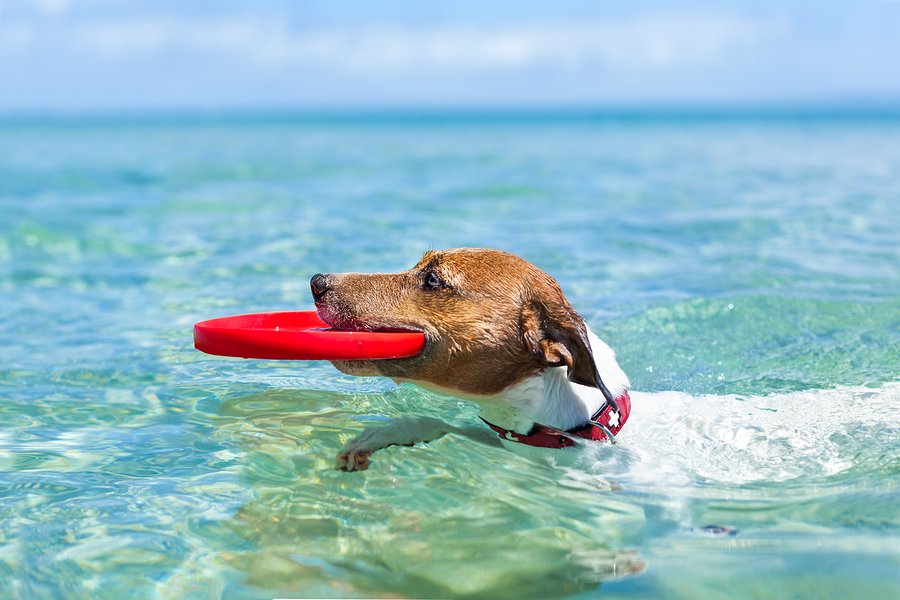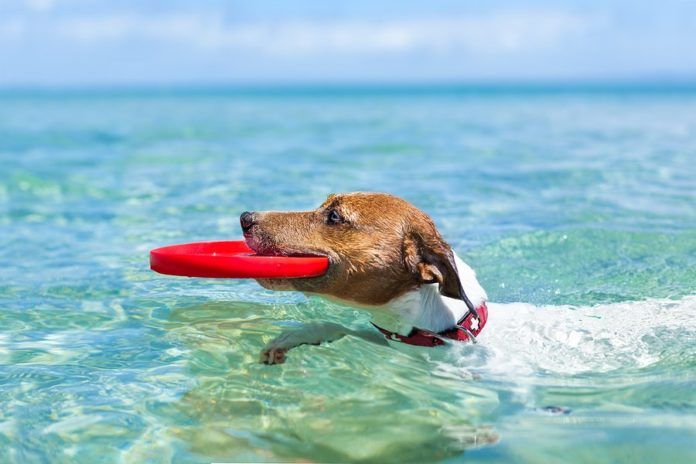While in the upcoming months you know to don light, loose clothing and slather yourself with sunscreen and, when necessary, bug repellent, you may not be as aware that your dog needs summer safety provisions, too. Sun, bugs, barbecues, and other warm-weather features can pose hazards for your dog that you may not have thought of. What better time to think of them than now?
Bugs and other critters. You already know to apply flea and tick ointment, which wards off a host of potential troubles by keeping ticks from burrowing into your dog’s skin and potentially causing Lyme disease; preventing mosquitoes from using your dog as a snack bar or a surface on which to lay eggs; and even keeping away biting flies and lice. And the monthly heartworm medication you give your pet may ward off other parasitic worms. But there are, in truth, many critters, from bees to spiders to snakes and more, that are potentially able to sting or bite your dog while he is out exploring or even resting near their hiding spots. Sometimes, a bite or sting from the wrong animal can necessitate a fast trip to the emergency room. But in some cases, such as a bee sting, having Benadryl on hand might be enough to calm swelling, itching, and hives (but does not replace a call to the vet’s office to see whether the dog should be brought in right away).
Barbecues and picnics. Sure, it’s nice to be able to allow a dog near the outdoor action, but it’s not unreasonable to expect that your pet will want in on the meal itself, sometimes helping himself to the bounty in ways that can cause him harm. For instance, your dog can’t know how hot the grill is, or how searing the savory meats he smells over the coals. It takes only one jump toward the food source to cause a serious burn of the tongue or some other part of the body. Make sure someone’s keeping him away from the heat and any sizzling delicacies that may fall from the barbecue.
Another opportunity, as perceived by your dog, is the variety of foods he can salvage from under picnic tables, plastic garbage bags, or leftovers not carried away by the people who used the area before you. Remember, it could take just a few grapes fallen under the picnic table to cause hemolytic anemia, or a bone remnant to necessitate an endoscopic procedure under anesthesia to remove a lodged fragment. Foods seasoned with onion and garlic are toxic to dogs, too. Letting your dog wander out of sight increases his chances of finding tasty morsels that can do him in — or at least lay him low. And offering your dog some of the fatty meats you may be eating may, no matter how much he begs, distress his digestive system, particularly if he has previously had pancreatitis. Some dogs may even get into drinks, including alcoholic beverages. A drunk dog is a very unwell dog.
Heat. Among the greatest risks for heat stroke is the quick stopping off for “this and that,” requiring you to leave the dog in the car “for just a few minutes.” Even though outdoor temperatures might only be in the mid-70s and you make sure to leave the windows open a crack as you head off for your errand, temperatures inside the vehicle can soar to 100 degrees within minutes, which may be about how long it will take if you have just two people in front of you on line. That’s particularly so if the sky is cloudless and even more so if your car is a dark color, absorbing the sun’s rays.
The potential upshot of a long line inside the store or a chance quick conversation with a neighbor before you head back to the car: irreparable organ failure and sometimes even death. If you have to run errands, don’t kill two birds with one stone. Bring the dog back home after taking him for a walk, then drive back out and shop for your sundries.
Another dicey enclosure is the doghouse, which your dog may seek to get away from the intense midday or late-day sun. Unfortunately, the single doghouse opening at the front of the structure does not provide for cross ventilation, so heat becomes trapped. A much better bet for your dog is a shady, open spot in your yard.
Other helpful items to make your dog’s yard time more enjoyable and safe are a bowl of fresh water (put in a few ice cubes) and perhaps a kiddie pool for a wet cool-down at will.
Owners of brachycephalic breeds like boxers, bulldogs, and Pekingese, take special note: these dogs have difficulty breathing to begin with so they really need to be kept out of debilitating heat. Elderly, very young, and frail dogs should also be kept from too much time in the sun. With all dogs, keep an eye out for excessive panting, particularly when exercising in warm weather. That’s a warning sign that your pet is struggling to cool off. Having some bottled water on you for your dog’s sake is never a bad idea.
Keep in mind, too, that the sun bakes everything, including asphalt and sand. If you are out for a walk or off to the beach, test the ground with your own bare feet. If you feel like they’re burning, that’s how your dog’s paws will feel. In such cases, because your dog doesn’t have flip-flops, put booties on his paws as he makes his way from the sand to the water so he can reach the surf comfortably. And limit walking time to early morning and early evening. If possible, find shaded areas to walk that include grass.
Sunshine. Just like you, your dog is susceptible to sunburn. While it may seem like a good idea to shear your dog’s hair to allow better air circulation and keep his body cooler, that can have the unintended effect of increasing the chances for sunburn because skin is more exposed. Rather than excessive trimming of your dog’s coat, trim it only somewhat, and lessen the thickness of hair by using an undercoat rake, available at most pet shops, to lighten the amount of hair your dog carries around in the summer heat — and to allow the air to reach his skin without exposing it to the sun. Some dogs may already have exposed skin due to their breed. In that case, placing a light t-shirt over your dog in much the same way you might put a t-shirt on a kid at the beach can help. For hairless or nearly hairless dogs, you should also speak with your veterinarian about safe canine sunblocks.
Plants. Some of the most common plants and flowers you cultivate and enjoy in your garden may prove toxic to your dog. Bulbs of the daffodil and tulip (is your dog a digger?); climbing morning glories and wisteria; and azaleas, day lilies, hydrangeas, and other plants may harm your dog if ingested. For a full list of plants and flowers to watch out for, visit aspca.org, click on “Pet Care,” and then click on “Animal Poison Control” toward the right side of the page.
Also, don’t let a dog onto a lawn that has been treated with fertilizer and/or a pesticide, which can sicken him. Make sure to wait at least 24 hours, if not longer.
Pools. Not all dogs “naturally” know how to swim, and some simply can’t due to their body dimensions. For example, dogs with short legs, such as Basset hounds, dachshunds and bulldogs may have a hard time paddling fast enough to keep their bodies afloat. Older dogs, fearful dogs, or frail dogs may also falter while in the water. Floating devices made specifically for dogs can be used, but you must stay in the water with your pet, just as you would with a toddler.
Bigstock


Dogs who shy away from water should still be introduced to the pool and made familiar with a ramp or steps that they can use to exit safely just in case they accidentally find themselves in rather than out. Truth be told, so should dogs who like to swim — they may be the ones more likely to find themselves needing a safe way out.





